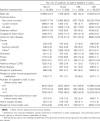The burden of community-acquired pneumonia in seniors: results of a population-based study
- PMID: 15578365
- PMCID: PMC7108010
- DOI: 10.1086/425615
The burden of community-acquired pneumonia in seniors: results of a population-based study
Abstract
Background: Pneumonia is recognized as a leading cause of morbidity in seniors. However, the overall burden of this disease--and, in particular, the contribution of ambulatory cases to that burden--is not well defined. To estimate rates of community-acquired pneumonia and to identify risk factors for this disease, we conducted a large, population-based cohort study of persons aged >or=65 years that included both hospitalizations and outpatient visits for pneumonia.
Methods: The study population consisted of 46,237 seniors enrolled at Group Health Cooperative who were observed over a 3-year period. Pneumonia episodes presumptively identified by International Classification of Diseases, Ninth Revision, Clinical Modification codes assigned to medical encounters were validated by medical record review. Characteristics of participants were defined by administrative data sources.
Results: The overall rate of community-acquired pneumonia ranged from 18.2 cases per 1000 person-years among persons aged 65-69 years to 52.3 cases per 1000 person-years among those aged >or=85 years. In this population, 59.3% of all pneumonia episodes were treated on an outpatient basis. In multivariate analysis, risk factors for community-acquired pneumonia included age, male sex, chronic obstructive pulmonary disease, asthma, diabetes mellitus, congestive heart failure, and smoking.
Conclusions: On the basis of these data, we estimate that roughly 915,900 cases of community-acquired pneumonia occur annually among seniors in the United States and that approximately 1 of every 20 persons aged >or=85 years will have a new episode of community-acquired pneumonia each year.
Figures





Comment in
-
Use of population-based cohort data to assess community-acquired pneumonia: a powerful approach.Clin Infect Dis. 2004 Dec 1;39(11):1651-3. doi: 10.1086/425621. Epub 2004 Nov 8. Clin Infect Dis. 2004. PMID: 15578366 No abstract available.
References
-
- Marston BJ, Plouffe JF, File TM, Jr, et al. Incidence of community-acquired pneumonia requiring hospitalization. results of a population-based active surveillance study in Ohio. The Community-Based Pneumonia Incidence Study Group. Arch Intern Med. 1997;157:1709–18. - PubMed
-
- Hoyert DL, Arias E, Smith BL, Murphy SL, Kochanek KD. Deaths: final data for 1999. Natl Vital Stat Rep. 2001;49:1–113. - PubMed
-
- Kaplan V, Angus DC, Griffin MF, Clermont G, Scott Watson R, Linde-Zwirble WT. Hospitalized community-acquired pneumonia in the elderly: age- and sex-related patterns of care and outcome in the United States. Am J Respir Crit Care Med. 2002;165:766–72. - PubMed
-
- Kochanek KD, Smith B. Deaths: preliminary data for 2002. National Vital Statistics Reports. 2004;52:1–48. - PubMed
-
- Jackson LA, Neuzil KM, Yu O, et al. Effectiveness of pneumococcal polysaccharide vaccine in older adults. N Engl J Med. 2003;348:1747–55. - PubMed
Publication types
MeSH terms
LinkOut - more resources
Full Text Sources
Medical

